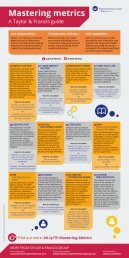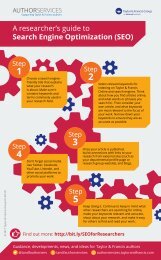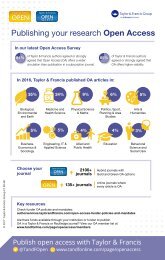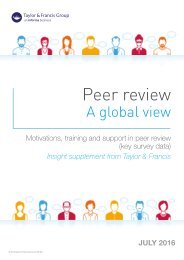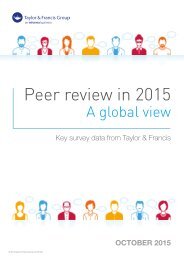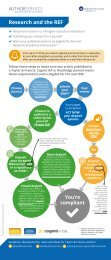White paper
Peer Review in 2015
Peer Review in 2015
You also want an ePaper? Increase the reach of your titles
YUMPU automatically turns print PDFs into web optimized ePapers that Google loves.
4<br />
The ethics of peer review<br />
Do some peer review models address ethical concerns?<br />
A sensitive issue?<br />
There was a notable drop-off in the response rate at this<br />
point in the survey. In previous Taylor & Francis surveys<br />
of this length and complexity, there were up to a fifth<br />
fewer respondents to the last question than the first<br />
– with drop-outs throughout the course of the survey.<br />
Unusually here, there was a sizeable, and sudden,<br />
drop-off in the response rate at the beginning of this<br />
section: 11% of respondents did not answer this set<br />
of questions, and a minority of those returned for the<br />
following section.<br />
Experiences of bias and discrimination<br />
Respondents were asked to rate how common they<br />
felt a set of ethical situations are in peer review<br />
practice currently, with 1 being extremely rare and 10<br />
extremely common.<br />
Researchers rated regional and seniority bias highest,<br />
and suggest that double blind peer review is most<br />
capable of preventing any reviewer discrimination based<br />
on aspects of an author’s identity. Reviewers falsifying<br />
their identity and gender bias was rated lowest of the list.<br />
There have been suggestions that different peer review models could<br />
reduce the prevalence of potential ethical problems by, for instance,<br />
changing whether the author and reviewer are aware of each other’s<br />
identities, or by the prospect of having reviews published online.<br />
Unsurprisingly, respondents scored double blind review as most effective<br />
at preventing discrimination based on identity, and for avoiding overly<br />
positive reviews by reviewers known to the author. This is concurrent<br />
with findings in the 2008 PRC study, which found:<br />
“Double-blind review was primarily supported because of its perceived<br />
objectivity and fairness. Many respondents did however point out that<br />
there were great difficulties in operating it in practice because it was<br />
frequently too easy to identify authors.”<br />
“I think that if both the<br />
authors’ and reviewers’<br />
names are known to each<br />
other, it is more difficult to<br />
delay or belittle the <strong>paper</strong><br />
of another competitor<br />
researcher.”<br />
Researcher, Geology, Italy<br />
In focus groups, there was less unprompted<br />
engagement with ethical questions than practical ones,<br />
with more prompts needed to uncover any issues.<br />
}<br />
“Peer review can be used as a gatekeeping mechanism to keep certain<br />
views out of circulation. In which article are there not personal views?<br />
Which personal views should be in the public domain and which shouldn’t?”<br />
Researcher, Anthropology, South Africa<br />
Discrimination based<br />
on identity<br />
HSS<br />
STM<br />
1<br />
1<br />
SB<br />
3.3<br />
O<br />
4.0<br />
4.4<br />
PP<br />
OP<br />
4.9<br />
O<br />
4.9<br />
OP<br />
5.5<br />
DB<br />
8.0<br />
DB<br />
7.9<br />
10<br />
10<br />
4.5<br />
SB<br />
5.3<br />
PP<br />
Perception of prevalence of ethical issues<br />
Prevalence of the following situations in the peer review process, from 1 (extremely rare) to 10 (extremely common).<br />
Scores above 5.5 means this happens more often than not.<br />
Delay of competitor<br />
research<br />
HSS<br />
1<br />
SB<br />
3.2<br />
O<br />
4.7<br />
OP<br />
5.2<br />
10<br />
“Some of the reviewers don’t<br />
exist. The author forges a name,<br />
creates an identity, applies for a<br />
new mailbox and reviews their<br />
<strong>paper</strong> themselves. They submit<br />
their <strong>paper</strong> the first day and get<br />
their comments the next day.”<br />
Researcher, Healthcare, China<br />
I used to be at a university<br />
which is low ranking in my<br />
current field. When I was<br />
there I couldn’t get a <strong>paper</strong><br />
accepted but now I am at a<br />
well-respected institution, I<br />
feel some <strong>paper</strong>s are accepted<br />
too easily!”<br />
Researcher, Environmental<br />
Science, UK<br />
HSS<br />
7.1<br />
Seniority bias<br />
6.2<br />
Regional bias<br />
5.3<br />
Review rings<br />
4.9<br />
Competitor<br />
delay<br />
4.8<br />
Competitor<br />
espionage<br />
3.7<br />
Gender bias<br />
2.5<br />
False Identities<br />
STM<br />
6.9<br />
Seniority bias<br />
5.9<br />
Regional bias<br />
5.5<br />
Review rings<br />
5.2<br />
Competitor<br />
delay<br />
5.1<br />
Competitor<br />
espionage<br />
3.0<br />
Gender bias<br />
2.9<br />
False Identities<br />
“I know of groups now planning<br />
for the next REF by thinking<br />
about which special issues to<br />
suggest enabling publication in<br />
a certain journal; and special<br />
issue editors can be influenced<br />
to use certain reviewers.”<br />
Researcher, Business and<br />
Economics, UK<br />
Asked about steps that can be taken<br />
to ameliorate these problems (such as<br />
using only initials to disguise gender<br />
or switching institutional affiliation), for<br />
each method a majority (>50%) said<br />
they never do this. The only exception<br />
(1 -2% short of a majority) was asking<br />
competitor labs not to review the<br />
work, which is considered standard<br />
practice in many STM subjects.<br />
STM<br />
HSS<br />
STM<br />
1<br />
Overly positive reviews<br />
1<br />
1<br />
SB<br />
3.5<br />
SB<br />
4.0<br />
O<br />
3.9<br />
OP<br />
4.6<br />
4.5<br />
PP<br />
SB<br />
4.3<br />
5.1<br />
PP<br />
5.4<br />
DB<br />
PP OP<br />
5.65.8<br />
“In open review, the authors know whether the<br />
reviewers are their competitors which might<br />
prevent delay in review and idea transfer.”<br />
Researcher, Biological Sciences, United States<br />
4.7<br />
O<br />
5.4<br />
O<br />
PP<br />
5.3<br />
5.4<br />
OP<br />
5.7<br />
DB<br />
6.9<br />
DB<br />
6.9<br />
DB<br />
10<br />
10<br />
10<br />
SB = Single blind peer review<br />
DB = Double blind peer review<br />
O = Open peer review<br />
OP = Open and published peer review<br />
PP = Post-publication peer review<br />
N.B Please see page 19 for definitions,<br />
as given in our survey.<br />
12<br />
PEER REVIEW IN 2015 A GLOBAL VIEW<br />
THE ETHICS EXECUTIVE OF PEER SUMMARY REVIEW 13





